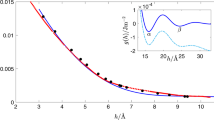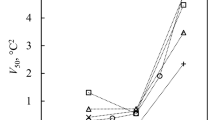Abstract
IT has been known for many years that when supercooled water suddenly freezes, whisker-like growths may occasionally form on the upper side of the layer of ice covering the water. It would seem that this was first reported by H. G. Dorsey in 1921 (ref. 1), but it has since been mentioned by several other observers2–6.
This is a preview of subscription content, access via your institution
Access options
Subscribe to this journal
Receive 51 print issues and online access
$199.00 per year
only $3.90 per issue
Buy this article
- Purchase on Springer Link
- Instant access to full article PDF
Prices may be subject to local taxes which are calculated during checkout
Similar content being viewed by others
References
Dorsey, H. G., Phys. Rev., 18, 162 (1921).
Erlenmeyer, H., Helv. Chim. Acta, 13, 1006 (1930).
Alty, T., Phil. Mag., 15, 82 (1933).
Bally, O., Helv. Chim. Acta, 18, 475 (1935).
Meyer, J., and Pfaff, W., Z. anorg. Allg. Chem., 224, 305 (1935).
Dorsey, N. E., Trans. Amer. Phil. Soc., 38, 247 (1948).
Author information
Authors and Affiliations
Rights and permissions
About this article
Cite this article
HAYWARD, A. Growth of Ice Tubes. Nature 211, 172–173 (1966). https://doi.org/10.1038/211172a0
Issue Date:
DOI: https://doi.org/10.1038/211172a0
Comments
By submitting a comment you agree to abide by our Terms and Community Guidelines. If you find something abusive or that does not comply with our terms or guidelines please flag it as inappropriate.



